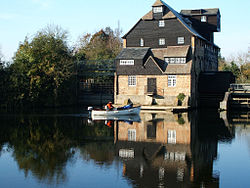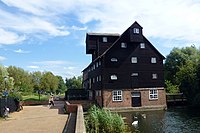Houghton Mill: Difference between revisions
No edit summary |
m →Outside links: ioe -> nhle, replaced: {{IoE|54103 → {{NHLE|1128403 |
||
| Line 30: | Line 30: | ||
{{commons}} | {{commons}} | ||
*{{NT link}} - National Trust | *{{NT link}} - National Trust | ||
*{{ | *{{NHLE|1128403}} | ||
Latest revision as of 08:12, 19 September 2019
| Houghton Mill | |
|
National Trust | |
|---|---|
 Houghton Mill | |
| Grid reference: | TL28197196 |
| Location: | 52°19’51"N, 0°7’13"W |
| Information | |
Houghton Mill is a water mill on the Great Ouse in the pretty village of Houghton in Huntingdonshire. It is owned and preserved by the National Trust.
History
Various mills have occupied this spot since the first building was erected in the year 969. In the Middle Ages, the mill was owned by the nearby Benedictine Abbey, and peasants were under an obligation to have their flour ground in the mill. Part of the flour was withheld as payment by the miller. When in 1500 the Abbot diverted the river water in order to supply the mill with sufficient power, the neighbouring village was flooded. The villagers rose up in protest, and fifteen years later they were granted permission to change the course of the water in case of an emergency.
At the Dissolution of the Monasteries, ownership of the mill reverted to the Crown.
The best-known miller is the nineteenth-century Quaker Potto Brown, a wealthy man who was so pious that he carried his ledgers to family prayer meetings in order to discuss with his Maker debts owed him. After his death, a bronze bust of him was erected.
The present building

Although there has been a mill on this site for most of Houghton's history, the original mill site (certainly in the time of the Domesday Book) was approximately half a mile along the river towards Huntingdon. The original mill pond is still there but now appears to be a natural backwater.
The present building was probably built in the 17th century, and was extended in the 19th century. In the 1930s, the mill was decommissioned. Local residents bought the building and it was given to the National Trust. After the war, the mill was in use as a youth hostel, and was one of the few YHA establishments where smoking was forbidden because of fire hazard.
In 1999, the National Trust put in new millstones. Flour is still being milled, and the building is a tourist centre, with a camping site nearby.
Outside links
| ("Wikimedia Commons" has material about Houghton Mill) |
- Houghton Mill - National Trust
- National Heritage List 1128403: Houghton Mill
